 W
WCorvus is a widely distributed genus of medium-sized to large birds in the family Corvidae. It includes species commonly known as crows, ravens and rooks. The species commonly encountered in Europe are the carrion crow, the hooded crow, the common raven and the rook; those discovered later were named "crow" or "raven" chiefly on the basis of their size, crows generally being smaller. The genus name is Latin for "crow".
 W
WThe American crow is a large passerine bird species of the family Corvidae. It is a common bird found throughout much of North America. American crows are the New World counterpart to the carrion crow and the hooded crow. Although the American crow and the hooded crow are very similar in size, structure and behavior, their calls and visual appearance are different. The American crow, nevertheless, occupies the same ecological niche that the hooded crow and carrion crow do in Eurasia.
 W
WThe Australian raven is a passerine bird in the genus Corvus native to much of southern and northeastern Australia. Measuring 46–53 centimetres (18–21 in) in length, it has all-black plumage, beak and mouth, as well as strong grey-black legs and feet. The upperparts are glossy, with a purple, blue, or green sheen, and its black feathers have grey bases. The Australian raven is distinguished from the Australian crow species by its throat hackles, which are prominent in adult birds. Older adult individuals have white irises, younger adults have white irises with an inner blue rim, while younger birds have dark brown irises until fifteen months of age, and hazel irises with an inner blue rim around each pupil until age two years and ten months. Nicholas Aylward Vigors and Thomas Horsfield described the Australian raven in 1827, its species name (coronoides) highlighting its similarity with the carrion crow. Two subspecies are recognized, which differ slightly in calls and are quite divergent genetically.
 W
WThe Banggai crow is a member of the crow family from Banggai regency in the province of Central Sulawesi in Indonesia. It is listed as critically endangered by IUCN. It was feared extinct, but was finally rediscovered during surveys on Peleng Island off the southeast coast of Sulawesi by Indonesian ornithologist Mochamad Indrawan in 2007 and 2008.
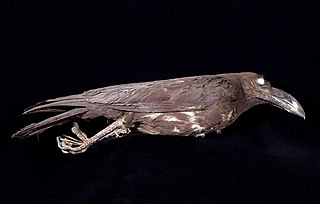 W
WThe brown-headed crow is a passerine bird of the genus Corvus in the family Corvidae. Endemic to Indonesia, it has a fragmented distribution in subtropical or tropical moist lowland forest and subtropical or tropical mangrove forest. It is threatened by habitat destruction and the IUCN has rated it as being "near-threatened".
 W
WThe brown-necked raven is a larger bird than the carrion crow though not as large as the common raven. It has similar proportions to the common raven but the bill is not so large or deep and the wings tend to be a little more pointed in profile. The head and throat are a distinct brownish-black giving the bird its English name, while the rest of the plumage is black glossed with purple, blue or purplish-blue. Like the Common raven, Thick-billed raven and White-necked raven, it is one of the larger raven species. The smaller raven species are the Australian raven, Forest raven, Little raven, Fan-tailed raven and Chihuahuan raven with the Thick-billed raven being the world's largest raven species and the Chihuahuan raven being the smallest. The feathers of this species often fade quite quickly to a brownish black and the bird can look distinctly brown by the time it moults. The feet, legs and bill are black. The dwarf raven was formerly considered a subspecies but this bird now appears to be closer to the pied crow than this species.
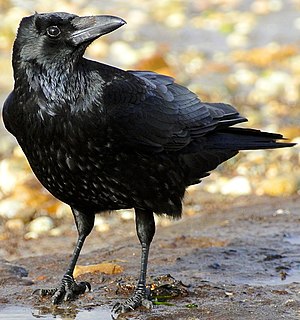 W
WThe carrion crow is a passerine bird of the family Corvidae and the genus Corvus which is native to western Europe and the eastern Palearctic. Alongside its close relative, the formerly-conspecific hooded crow, the carrion crow occupies the same ecological niche in Europe as that of the American crow in North America.
 W
WThe Chatham raven is a prehistoric raven formerly native to the Chatham Islands. The closely related New Zealand raven, C. antipodum occurred in the North and South Islands of New Zealand. C. antipodum was formerly included in C. moriorum, and later considered a distinct species, however in 2017 genetic research determined that the two raven populations were subspecies rather than separate species, having only split 130,000 years ago.
 W
WThe Chihuahuan raven is a species of crow in the family Corvidae that is native to the United States and Mexico.
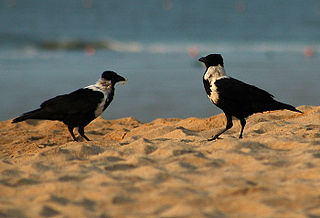 W
WThe collared crow, also known as the ring-necked crow or white-collared crow, is a member of the family Corvidae native to China and north of Vietnam.
 W
WThe common raven, also known as the western raven or northern raven when discussing the raven at the subspecies level, is a large all-black passerine bird. Found across the Northern Hemisphere, it is the most widely distributed of all corvids. There are at least eight subspecies with little variation in appearance, although recent research has demonstrated significant genetic differences among populations from various regions. It is one of the two largest corvids, alongside the thick-billed raven, and is possibly the heaviest passerine bird; at maturity, the common raven averages 63 centimetres in length and 1.2 kilograms in mass. Although their typical lifespan is considerably shorter, common ravens can live more than 23 years in the wild. Young birds may travel in flocks but later mate for life, with each mated pair defending a territory.
 W
WThe Puerto Rican crow is an extinct crow species in the family Corvidae that was endemic to Puerto Rico and the United States Virgin Islands. Little is known about its habitat, but it possibly died out after the colonization of humans on these islands.
 W
WThe Cape crow or black crow is slightly larger than the carrion crow and is completely black with a slight gloss of purple in its feathers. It has proportionately longer legs, wings and tail too and has a much longer, slimmer bill that seems to be adapted for probing into the ground for invertebrates. The head feathers have a coppery-purple gloss and the throat feathers are quite long and fluffed out in some calls and displays.
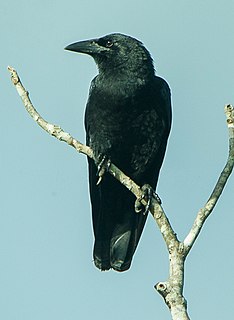 W
WThe Cuban crow is one of four species of crow that occur on islands in the Caribbean. It is closely related to the white-necked crow and Jamaican crow, with which it shares similar features. The fourth Caribbean crow, the palm crow, is a later arrival in evolutionary terms, and shows characteristics more akin to North American species, such as the fish crow, which it is probably closely related to.
 W
WThe eastern carrion crow is a member of the crow family and a subspecies of the carrion crow. Differences from the nominate subspecies include a larger size, at a length about 500 millimetres (20 in), and more graduated outer tail feathers. The eastern carrion crow is found in Siberia from the Yenisei to Japan, south to Central Asia, Afghanistan, Eastern Iran, Kashmir, Tibet and northern China. They generally lay three to five eggs in trees or buildings. The eggs show no difference from the nominate subspecies.
 W
WThe eastern jungle crow is a bird in the family Corvidae. It is found in China, Bangladesh, India, Myanmar, Nepal, Bhutan, and Thailand.
 W
WThe fan-tailed raven is a passerine bird of the crow family native to Eastern Africa and the Arabian Peninsula.
 W
WThe fish crow is a species of crow associated with wetland habitats in the eastern and southeastern United States.
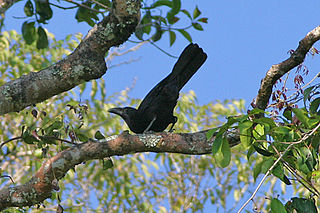 W
WThe Flores crow is a species of bird in the family Corvidae. It is endemic to Indonesia.
 W
WThe forest raven, also commonly known as the Tasmanian raven, is a passerine bird in the family Corvidae native to Tasmania and parts of southern Victoria, such as Wilsons Promontory and Portland. Populations are also found in parts of New South Wales, including Dorrigo and Armidale. Measuring 50–53 cm (20–21 in) in length, it has all-black plumage, beak and legs. As with the other two species of raven in Australia, its black feathers have grey bases. Adults have white irises; younger birds have dark brown and then hazel irises with an inner blue rim. New South Wales populations are recognised as a separate subspecies C. tasmanicus boreus, but appear to be nested within the Tasmanian subspecies genetically.
 W
WThe grey crow, formerly known as the bare-faced crow, is about the same size as the Eurasian carrion crow but has somewhat different proportions and quite atypical feather pigmentation during the juvenile phase for a member of this genus.
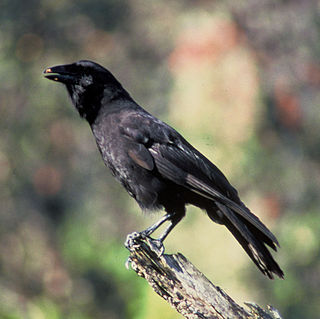 W
WThe Hawaiian crow or ʻalalā is a species of bird in the crow family, Corvidae, that is currently extinct in the wild, though reintroduction programs are underway. It is about the size of the carrion crow at 48–50 cm (19–20 in) in length, but with more rounded wings and a much thicker bill. It has soft, brownish-black plumage and long, bristly throat feathers; the feet, legs and bill are black. Today, the Hawaiian crow is considered the most endangered of the family Corvidae. They are recorded to have lived up to 18 years in the wild, and 28 years in captivity. Some Native Hawaiians consider the Hawaiian crow an ʻaumakua.
 W
WThe high-billed crow or deep-billed crow was a species of large, raven-sized crow that was endemic to the island of Maui in the Hawaiian Islands. It was pushed to extinction due to the arrival of people and pests like rats.
 W
WThe hooded crow is a Eurasian bird species in the genus Corvus. Widely distributed, it is also known locally as Scotch crow and Danish crow. In Ireland, it is called caróg liath or grey crow, as its name also means in the Slavic languages and in Danish. It is called "mist crow" (Nebelkrähe) in German, and "dolman crow" in Hungarian. Found across Northern, Eastern, and Southeastern Europe, as well as parts of the Middle East, it is an ashy grey bird with black head, throat, wings, tail, and thigh feathers, as well as a black bill, eyes, and feet. Like other corvids, it is an omnivorous and opportunistic forager and feeder.
 W
WThe house crow, also known as the Indian, greynecked, Ceylon or Colombo crow, is a common bird of the crow family that is of Asian origin but now found in many parts of the world, where they arrived assisted by shipping. It is between the jackdaw and the carrion crow in size but is slimmer than either. The forehead, crown, throat and upper breast are a richly glossed black, whilst the neck and breast are a lighter grey-brown in colour. The wings, tail and legs are black. There are regional variations in the thickness of the bill and the depth of colour in areas of the plumage.
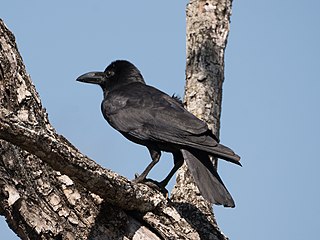 W
WThe Indian jungle crow is a species of crow found across the Indian Subcontinent south of the Himalayas. It is very common and readily distinguished from the house crow, which has a grey neck. In the past the species was treated as a subspecies of another crow species, but vocalizations and evidence from ectoparasite co-evolution and phylogenetic evidence have led to it being considered as a distinct species in modern taxonomic treatments. It differs in its voice from the large-billed crow found in the higher elevations of the Himalayas and the eastern jungle crow overlaps in the eastern part of its range. In appearance, it can be difficult to distinguish from either of these species although the plumage tends to be more uniformly glossed in purple and has a longer bill with a fine tip and a less arched culmen. The Himalayan species has a slightly wedge-shaped tail, unlike the rounded tail of the Indian jungle crow and tends to glide a lot.
 W
WThe Jamaican crow is a comparatively small corvid. It shares several key morphological features with two other West Indian species, the Cuban crow and the white-necked crow of Hispaniola, which are very closely related to it.
 W
WThe large-billed crow, formerly referred to widely as the jungle crow, is a widespread Asian species of crow. It is very adaptable and is able to survive on a wide range of food sources, making it capable of colonizing new areas, due to which it is often considered a nuisance, especially on islands. It has a large bill, which is the source of its scientific name macrorhynchos and it is sometimes known by the common name thick-billed crow. It can also be mistaken for a common raven. Johann Georg Wagler first described the species from a holotype obtained from Java in the year 1827. The eastern jungle crow and Indian jungle crow were once considered conspecific and together called the jungle crow.
 W
WThe following is a list of all currently recognized species within the genus Corvus.
 W
WThe little crow is an Australian species of crow, very similar to the Torresian crow in having white bases to the neck and head feathers but slightly smaller and with a slightly smaller bill. It has the same white iris that distinguish the Australian species from all other Corvus except a few island species to the north of Australia, and one from Eurasia, the jackdaw. Like the Australian raven, this species has a blue ring around the pupil.
 W
WThe little raven is a species of the family Corvidae that is native to southeastern Australia. An adult individual is about 48–50 cm (19–19.5 in) in length, with completely black plumage, beak, and legs; as with all Australian species of Corvus, the black feathers have a grey base, and the iris of the adult bird is white . Although the little raven was first named by Gregory Mathews in 1912, it was only in 1967 that there was consensus to separate it from the Australian raven as a distinct species.
 W
WThe long-billed crow is a crow that is endemic to the Northern Maluku Islands. This crow is large with glossy plumage, a large bill and white irises. It is classified by the International Union for Conservation of Nature as a "near-threatened species".
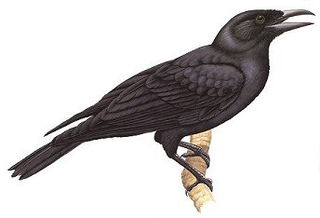 W
WThe Mariana crow is a species of the crow family from the South Pacific. It is a glossy black bird about 15 inches (38 cm) long and known only from the islands of Guam and Rota.
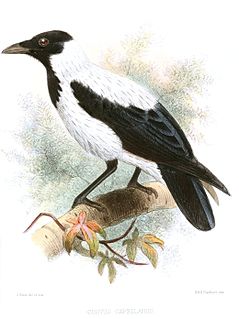 W
WThe Mesopotamian crow, also known as the Iraq pied crow, is a bird subspecies of the genus Corvus. The Mesopotamian crow is native to the region of Mesopotamia in southern Iraq and southwestern Iran, between the Tigris and Euphrates rivers.
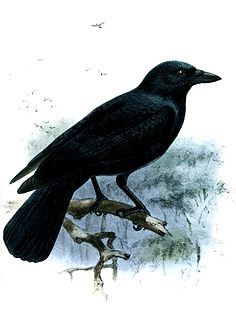 W
WThe New Caledonian crow is a medium-sized member of the family Corvidae, native to New Caledonia. The bird is often referred to as the 'qua-qua' due to its distinctive call. It eats a wide range of food, including many types of invertebrates, eggs, nestlings, small mammals, snails, nuts and seeds. The New Caledonian crow sometimes captures grubs in nooks or crevices by poking a twig at the grub to agitate it into biting the twig, which the crow then withdraws with the grub still attached. This method of feeding indicates the New Caledonian crow is capable of tool use. They are also able to make hooks. This species is also capable of solving a number of sophisticated cognitive tests which suggest that it is particularly intelligent. As a result of these findings, the New Caledonian crow has become a model species for scientists trying to understand the impact of tool use and manufacture on the evolution of intelligence.
 W
WThe New Zealand raven was native to the North Island and South Island of New Zealand but has been extinct since the 16th century. There were two subspecies: the North Island raven and the South Island raven. Another closely related species, the Chatham raven, occurred on the Chatham Islands.
 W
WThe Palawan crow is a passerine bird of the family Corvidae, in the genus Corvus.
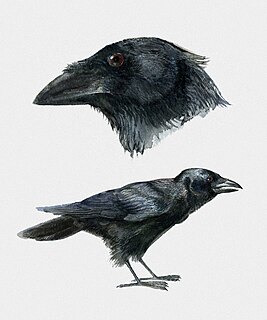 W
WThe palm crow is a relatively small corvid that occurs on the Caribbean island of Hispaniola and Cuba, where it was formerly very frequent, but is now reduced in population.
 W
WThe pied crow is a widely distributed African bird species in the crow genus.
 W
WThe pied raven is an extinct colour morph of the North Atlantic subspecies of the common raven which was only found on the Faroe Islands and was last seen in 1902. It had large areas of white feathering, most frequently on the head, the wings and the belly and its beak was light brown. Apart from that, it looked like the black North Atlantic ravens.
 W
WThe piping crow is a species of bird in the family Corvidae. It is endemic to Sulawesi in Indonesia. Its natural habitat is subtropical or tropical moist lowland forest.
 W
WThe rook is a member of the family Corvidae in the passerine order of birds. It is found in the Palearctic, its range extending from Scandinavia and western Europe to eastern Siberia. It is a large, gregarious, black-feathered bird, distinguished from similar species by the whitish featherless area on the face. Rooks nest collectively in the tops of tall trees, often close to farms or villages, the groups of nests being known as rookeries.
 W
WRook shooting was a previously popular sport in the United Kingdom, in which young rooks were shot from tree branches, often using purpose-built rifles known as rook rifles. Rook shooting could serve as a form of pest control, a blood sport making living targets of animals, or a form of hunting for edible birds.
 W
WThe Sinaloa crow is a crow native to western Mexico.
 W
WThe slender-billed crow is a Passerine bird of the family Corvidae, in the genus Corvus. The violet crow has been found to be distinct genetically and separated as Corvus violaceus. The small crow has been split as Corvus samarensis and the Palawan crow has also been split as Corvus pusillus.
 W
WThe Somali crow, or dwarf raven, is approximately the size of the carrion crow, Corvus corone but with a longer bill and a somewhat more brownish cast to the feathers, especially when worn.
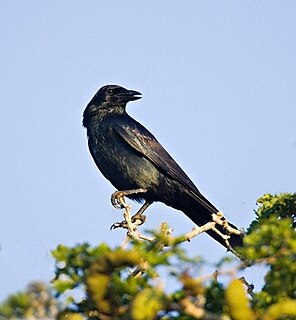 W
WThe Tamaulipas crow is a crow found in northeastern Mexico and southern Texas.
 W
WThe thick-billed raven, a corvid from the Horn of Africa, shares with the common raven the distinction of being the largest bird in the corvid family, and indeed the largest of the passerines. The thick-billed raven averages 64 cm (25 in) in length, with a range of 60 to 70 cm and weighs approximately 1.15 kg (2.5 lb) in females and 1.5 kg (3.3 lb) in males on average. Its size is about the same as the largest species of common raven but some common raven subspecies are rather smaller and, going on average weights, the thick-billed raven is likely the heaviest extant passerine. The thick-billed raven is about 25% heavier on average than the Australasian superb lyrebird, which is sometimes erroneously titled the largest passerine.
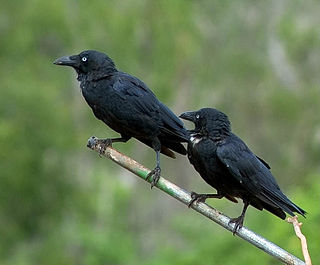 W
WThe Torresian crow, also called the Australian crow or Papuan crow, is a passerine bird in the crow family native to the north and west of Australia and nearby islands in Indonesia and Papua New Guinea. The species has a black plumage, beak and mouth with white irises. The base of the feathers on the head and neck are white. The Torresian crow is slightly larger with a more robust bill than the morphologically similar little crow.
 W
WThe violet crow is a species of the crow family, Corvidae, native to Seram, an island in Indonesia. It was long considered a subspecies of the slender-billed crow but has been shown to be divergent genetically. Violet crows have a dark black head and slightly blue black body and have a slightly shorter bill than most other crow species.
 W
WThe white-billed crow is a member of the crow family found on the Solomon Islands.
 W
WThe white-necked crow is the largest of the four Caribbean corvids. It is endemic to the island of Hispaniola ; it was formerly also extant on Puerto Rico, but has been extirpated there due to considerable forest clearance and hunting.
 W
WThe white-necked raven is somewhat smaller than the common raven or its nearest relative, the thick-billed raven C. crassirostris. It is native to eastern and southern Africa.